The story I am about to share comes from my friend Anisha Manjeni, a dedicated Yoga philosophy teacher at Sivananda Ashrams.
In a quiet forest hermitage, a wise Rishi taught his disciples the ancient ways of Dharma. They studied scriptures, debated ethics, and pondered right action. Yet, doubt remained in their hearts. Sensing their struggle, the Rishi chose another way to teach.
One day, he led them to a clearing where a hot air balloon stood waiting. Without explanation, he invited his four disciples to climb in. As they rose into the sky, the great forest unfolded beneath them like a living tapestry.
After some time, the Rishi pointed below.
“Look,” he said.

They saw a tiger stalking a gazelle. In one swift leap, the tiger caught its prey. As it dragged the gazelle away, the disciples noticed a small cub left behind, crying out for its mother. The tiger carried the gazelle back to its den, where its own cubs waited, thin and hungry. The tiger fed them.
The Rishi turned to his disciples and asked:
“Who acted with Dharma?”
But he warned them:
“If your answer is not true, the bottom of this basket will open, and you will fall.”
The first disciple answered quickly.
“The tiger acted in Adharma. He should have spared the gazelle who had a young one. There were others without offspring. He chose wrongly.”
The Rishi was silent. Then the bottom of the basket opened, and the disciple fell.
The second disciple spoke more carefully.
“No, the tiger acted in Dharma. He had to feed his cubs. His duty as a parent justified his actions.”
Once more, the basket opened, and he fell.
The third disciple thought deeply before speaking.
“It was the gazelle who acted in Adharma. It should have been more careful. It had a duty to protect its young and failed.”
The basket opened again. He, too, was gone.
Only the last disciple remained. The Rishi turned to him.
“And you? What is your judgment?”
The disciple closed his eyes. After a long pause, he said softly,
“My friends offered their judgments, but I do not know what is Dharma or Adharma in this moment. Who am I to say? Life is vast, and its truth is hidden from me.”
The Rishi smiled and said, “You may sit.”
The Teaching: Beyond Right and Wrong
In Yoga Therapy, we often guide people toward balance, health, and a meaningful life. We speak of Dharma—their duty, purpose, or right action. But this story reminds us: Dharma is not always clear. What seems right for one can be wrong for another. Life doesn’t always fit our ideas of fairness or justice.
Krishna speaks of this mystery in the Bhagavad Gita:
“Gahana karmano gatih”
“Unfathomable is the course of action.”
(Chapter 4, Verse 17)
Even the wise struggle to know what is truly right. At the end of the Gita, Krishna offers his final instruction:
“Sarva-dharman parityajya mam ekam sharanam vraja.”
“Abandon all varieties of dharma and surrender unto Me alone.”
(Chapter 18, Verse 66)
When certainty vanishes… when right and wrong blur… we are invited into surrender.
In a Nutshell
Surrender (Sharanagati) is not resignation or helplessness.
It is trust.
It is offering yourself to life, to the deeper intelligence that moves through all things.
Resting in not-knowing and allowing life to unfold.
Releasing the need to control or judge.

